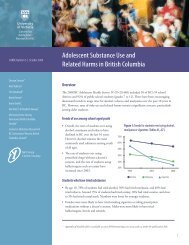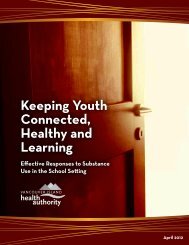A Review Of Research Into The Impacts Of Alcohol ... - CARBC
A Review Of Research Into The Impacts Of Alcohol ... - CARBC
A Review Of Research Into The Impacts Of Alcohol ... - CARBC
Create successful ePaper yourself
Turn your PDF publications into a flip-book with our unique Google optimized e-Paper software.
prompted reductions in high-risk consumption or related harms,<br />
and were “not appropriate” strategies. This review was published<br />
in the peer-reviewed International Journal of Drug Policy.<br />
An information bulletin prepared by the International Center for<br />
<strong>Alcohol</strong> Policies (1997), an organisation funded by several major<br />
alcohol manufacturers, provided a useful review of international<br />
practice on alcohol labelling and also concluded that, while<br />
there was some evidence of changes in awareness and knowledge<br />
of alcohol risks, there was none indicating positive behaviour<br />
change. This review, published in-house, also questioned the<br />
accuracy and appropriateness of the particular messages used in<br />
the US, and concluded alcohol education was too complicated to<br />
be reduced to simple messages on alcohol containers.<br />
4. Primary studies evaluating the impact of alcohol warning<br />
labels<br />
With the exception of a handful of reports dealing with<br />
the evaluation of hypothetical warning labels by different<br />
groups of subjects, one baseline study prior to the introduction<br />
of warning labels in Israel, and a couple of papers dealing with<br />
levels of public support for alcohol warning labels in Canada,<br />
all of this category of studies concerned evaluations of the<br />
impact of the US alcohol warning labels mandated by Congress<br />
in 1989. Several studies regarding US warning labels were<br />
concerned with testing the effectiveness of alternative labels,<br />
and identified problems with the visibility and impact of the<br />
unvarying message used (e.g. Crey et al, 2002). <strong>The</strong> great<br />
majority of studies of the US warning labels, however, were<br />
analyses of different aspects of the <strong>Alcohol</strong> <strong>Research</strong> Group<br />
(ARG) series of national surveys concerning the US warning<br />
labels reported at different stages between 1991 and 1995.<br />
Another major study employed annual surveys of Grade 10 and<br />
12 students from just before to five years after the introduction<br />
of US warning labels (McKinnon et al, 2000). Another study<br />
assessed the impacts of the warnings about birth defects on<br />
pregnant mothers attending an antenatal clinic (Hankin et al,<br />
1993). <strong>The</strong> main features of each of these three sets of studies<br />
will now be described in turn.<br />
(i) <strong>The</strong> ARG and ARF surveys of the general populations of<br />
US and Ontario, 1989 to 1994<br />
<strong>The</strong> US warning label legislation required a series of before<br />
and after surveys to be conducted to evaluate whether the<br />
legislation was achieving its stated objectives. <strong>The</strong>se were<br />
commissioned by the US National Institute of <strong>Alcohol</strong> Abuse<br />
and <strong>Alcohol</strong>ism (NIAAA). <strong>The</strong> ARG won the tender to conduct<br />
this work, and excellent overviews of these studies have been<br />
provided by Greenfield (1997) and Greenfield et al (1999).<br />
Anticipating the introduction of the US labelling in 1989, a<br />
baseline survey of the drinking behaviour, beliefs about alcohol,<br />
and awareness of warning labels among the adult US population<br />
was commissioned, in addition to four further surveys in 1990,<br />
1991, 1993 and 1994. <strong>The</strong> sample sizes were approximately<br />
2,000 individuals for the years 1989 to 1991 and 1,000 for<br />
1993 and 1994. Interviews were conducted by telephone with<br />
respondents contacted by random digit dialling. In 1990, 1991,<br />
1993 and 1994, comparison surveys were conducted in the<br />
control site of Ontario, Canada, but with smaller sample sizes<br />
of roughly 1,000 per survey, as part of a collaboration with the<br />
Addiction <strong>Research</strong> Foundation (ARF) of Ontario. In both sites,<br />
lifetime abstainers from alcohol were excluded from analyses,<br />
resulting in a loss of approximately 25% of respondents overall.<br />
In addition, a larger Ontario survey was available for 1989, with<br />
comparable data on public opinion regarding alcohol warning<br />
labels, though not on awareness of labels or their content.<br />
This particular evaluation was the only one identified with any<br />
kind of control series. One weakness of the “quasi-experimental<br />
design” used was that, for most measures of interest, there were<br />
no baseline data for the control site. <strong>The</strong> first Ontario survey<br />
occurred in 1990, i.e. after the introduction of warning labels<br />
in the US. Nonetheless, any continuing trends in the five years<br />
after implementation could be contrasted with those in the US.<br />
Needless to say, however, there are many factors that can affect<br />
levels of alcohol consumption in both the whole of the USA<br />
and in Ontario that were not controlled for, such as the price of<br />
alcoholic drinks, the extent of alcohol advertising, and changes in<br />
the physical availability of alcohol. <strong>The</strong>re was also some “leakage”<br />
of the warning labels into Ontario via cross-border purchases<br />
and exposure to the US warning labels during visits to the USA<br />
by Ontario residents. <strong>The</strong> amount of actual exposure to the<br />
labels was still substantially higher in the US than the Canadian<br />
samples. <strong>The</strong> surveys were conducted in each jurisdiction by<br />
the same organisations, and used standard sampling designs.<br />
However, a further problem was with response rates that dropped<br />
from 64% in 1990 to 53% in 1994 in the US samples, and from<br />
64% to 56% in Ontario over the same period. At least these<br />
response rates were similar, and dropping by a similar degree in<br />
the two data collection sites. <strong>The</strong>y compare favourably with the<br />
response rates to many other North American surveys. <strong>The</strong> data<br />
were “weighted” by the number of people in each household<br />
contacted and by age and sex, a statistical procedure designed to<br />
increase the extent to which the results were representative of the<br />
US and Ontario populations.<br />
Overall, despite the above shortcomings, this research program<br />
has the strongest design of all the others that were conducted<br />
to evaluate the impact of any alcohol warning labels, and most<br />
weight should be placed on its findings. Accordingly, the findings<br />
from this large study will be described below in some detail, with<br />
a main focus on the final analyses presented in 1999 when all<br />
data were to hand.<br />
Awareness of the warning labels<br />
By 1994, 43% of US respondents reported having seen the<br />
warning label, an increase from 30% in 1990. Much lower<br />
percentages of Canadians reported having seen the labels<br />
throughout the study period. Awareness of the labels was<br />
significantly higher by 1994 among young people (61% of 18<br />
to 29 year olds) and among heavy drinkers (74%). Among those<br />
claiming to have seen the labels, recall of the specific messages<br />
actually on the labels increased over the study period and, by<br />
A <strong>Review</strong> <strong>Of</strong> <strong>Research</strong> <strong>Into</strong> <strong>The</strong> <strong>Impacts</strong> <strong>Of</strong> <strong>Alcohol</strong> Warning Labels On Attitudes And Behaviour





